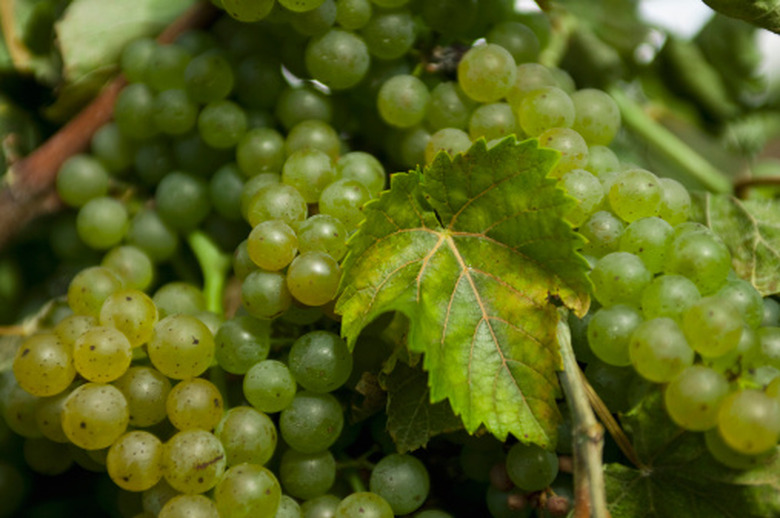Yellowing Leaves On A Grapevine
Grapes make up one of the oldest crops, and humans have been growing them for thousands of years. Some species, especially those that are native to North America, are easy to grow, but wine grapes can pose a challenge. In addition to nutritional deficiencies, grapes are susceptible to many fungal and viral diseases that can cause leaves to yellow and vines to die.
Grapes make up one of the oldest crops, and humans have been growing them for thousands of years. Some species, especially those that are native to North America, are easy to grow, but wine grapes can pose a challenge. In addition to nutritional deficiencies, grapes are susceptible to many fungal and viral diseases that can cause leaves to yellow and vines to die.
Deficiencies
A deficiency in one of the essential elements can cause grape leaves to turn yellow. Where the yellowing occurs depends on which element is lacking. Overall yellowing of the leaves and other green tissues indicates that grapes aren't receiving enough nitrogen. When the basal leaves turn yellow, grapes need more phosphorus. Potassium deficiencies appear in older leaves first. The leaves of white grape varieties turn yellow near the margin, and the yellowing then moves in toward the center of the leaf. Leaves of red-grape varieties turn red instead of yellow. When yellowing occurs between the veins of older leaves, white grape varieties are short on magnesium. Iron deficiencies show up as a yellowing of young leaves and new growth. If the deficiency is mild, the veins might stay green. A lack of manganese appears as yellowing between the main veins of older leaves.
- Grapes make up one of the oldest crops, and humans have been growing them for thousands of years.
- When yellowing occurs between the veins of older leaves, white grape varieties are short on magnesium.
Downy Mildew
Symptoms of downy mildew include the appearance of small, pale yellow lesions on the upper surface of the leaves and white or grayish fungal growth on the undersides of leaves. The lesions can grow larger and merge together, causing the leaves to turn brown or black and fall off the vine. Downy mildew infects grapes when the weather remains warm and wet for long periods of time. The fungus also grows on the grapes, which may shrivel or harden and fail to ripen. Control downy mildew with applications of fungicides.
Eutypa Dieback
Eutypa dieback is caused by a fungal infection that causes stunted shoots with leaves that cup upward. Shoots turn yellow or develop yellow streaks. One or more of the trunks may die, or the whole vine may die from wood rot. This disease progresses over a period of several years, but the initial infection usually occurs when the vine suffers a pruning wound. The fungus attacks the wound and releases spores whenever it rains. Control the eutypa fungus by removing and burning diseased trunks and vines.
- Symptoms of downy mildew include the appearance of small, pale yellow lesions on the upper surface of the leaves and white or grayish fungal growth on the undersides of leaves.
- The lesions can grow larger and merge together, causing the leaves to turn brown or black and fall off the vine.
Tomato/Tobacco Ringspot
Tomato and tobacco ringspot are viruses that infect French hybrid grapevines. The symptoms of both viruses are the same and include the appearance of small, yellow leaves and stunted vines. Ringspots are spread by the dagger nematode, a small wormlike creature that feeds on the roots of the grapevine. Control ringspot diseases by fumigating the soil before planting vines. Control in an established vineyard involves removing all infected vines and tilling the soil for one season before fumigating the soil and replanting with certified virus-tested plants.
Powdery Mildew
Symptoms of powdery mildew include the appearance of yellow spots on the upper surface of leaves, followed by a white, powdery fungus that can cover both sides of the leaf. Leaves may also dry out and drop prematurely. The white powder also appears on the fruit and dormant canes develop red blotchy areas. Fungicides can be used to control this disease, and they're more effective when used as protectants.
- Tomato and tobacco ringspot are viruses that infect French hybrid grapevines.
- The symptoms of both viruses are the same and include the appearance of small, yellow leaves and stunted vines.
